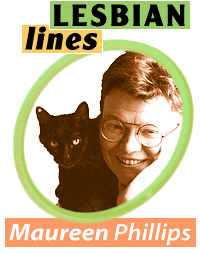Margaret Mead Made Me Gay is a collection of essays and excerpts written over the last 30 years by lesbian/feminist/butch anthropologist Esther Newton.
Newton is perhaps best known academically for her work on the culture of drag and drag queens, Mother Camp: Female Impersonators In America, first published in 1972, and her history of gay and lesbian life in Cherry Grove, Fire Island: Sixty Years In America’s First Gay And Lesbian Town, which appeared in 1993.
Newton did the field work for Mother Camp in the mid 1960s and it was originally written as her PhD thesis. The introduction accurately describes the collection as an intellectual autobiography. It’s possible to trace the development and refinement of both her politics and thought throughout the book.
One of the most interesting sections covers her involvement with the growing women’s liberation movement in the ’70s. She includes an essay that’s essentially an anthropological study of the consciousness-raising groups that were the foundation of the growing movement.
It’s tempting to dismiss the intense rhetoric and the seemingly rigid views (there’s so much talk of men being the enemy and how women must resist the oppressive rule of the patriarchy) that are associated with CR groups. But Newton makes it clear that, in the context of the time, the impact these groups had was incredibly powerful and did truly cause women to change their lives in significant ways.
Newton’s non-academic claim to fame is in her work in the area of sexual politics. Along with Joan Nestle, Amber Hollibaugh, Gayle Rubin and others, she was at the centre of a controversy that marked the ’80s – the so-called sex wars. This includes the huge question about the nature of sexual expression and sexual identity, and often focussed on the nature and role of pornography, as well as the important question of butch-femme relationships.
This collection includes an essay from 1984, “The Misunderstanding: Toward A More Precise Sexual Vocabulary,” which stands up today in terms of the clarity of its ideas and the urgency of its message. Newton tells about a disastrous attempt at sleeping with a friend, disastrous because at the time neither of them had a particularly sophisticated approach to sex, and therefore no way of understanding – let alone articulating – the ways their dynamic didn’t mesh.
Years later they discover that they’re both tops. She goes on to discuss the differences between sexual preference, erotic identity, erotic roles and erotic acts. In other words, there are significant distinctions between what you do, with whom you do it and how you feel about doing those things.
The collection could as easily have been called Gertrude Stein Made Me Butch, as Newton writes about discovering the work of Stein in 1961: “Little by little this idea of being Gertrude began to grow inside my head. It wasn’t yet about living in Paris or about writing, about being accepted as an equal by men within a very small select circle, and of living in a happy domesticated couple with heaps of good food. So naturally, the big thing was to find an Alice. But finding an Alice wasn’t easy….
“None of the women I met really deep down wanted to be an Alice. No matter how Alice they seemed, it always turned out that secretly they too wanted to be Gertrude, even if they’d never read anything about her. Unbelievable as it sounds, all those Alices wanted to use me as a model for becoming Gertrude themselves. And as they became more Gertrude, I fought with them more and desired them less.”
That is taken from an essay called “My Butch Career,” which is the most purely personal piece in the book. Newton traces her sexual development, which is to say how she learned to inhabit her erotic identity as a butch woman. The essay is personal, and yet the anthropologist in her marks her style here, too. Newton always detaches herself from the action in one way or another, which is not a shortcoming. Her distance adds to the solidity of her perspective.
Because the collection is so varied and wide-ranging – from drag queens in the Chicago of the ’60s to feminists in the ’70s to queer academics in the ’90s – the book provides fascinating glimpses into communities and cultures that are all part of the always difficult to define gay and lesbian community. Newton shows herself as an important chronicler of a vibrant and important period in queer history.
MARGARET MEAD MADE ME GAY:
PERSONAL ESSAYS, PUBLIC IDEAS.
By Esther Newton.
Duke University Press.
328 pages. $29.95.

 Why you can trust Xtra
Why you can trust Xtra


